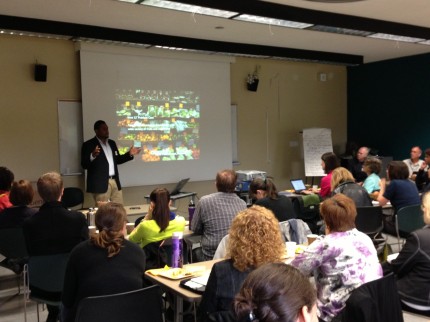Healthy Corner Stores: Workshop Discusses Increasing Access to Healthy Food in Toronto
Posted: June 19, 2013
Categories: Food in the News / GoodFoodBites / News from Sustain Members / News from Sustain Ontario
By: Danny Brown
On Friday June 7th in the summer-deserted hallways of Ryerson University, representatives from Toronto Food Strategy, Toronto Public Health, Toronto Community Housing Corporation (TCHC), the Toronto Transit Commission (TTC), and Sustain Ontario met for a day-long workshop to share information and explore opportunities to increase access to healthy and nutritious food in Toronto’s ubiquitous convenience stores.
Many of Sustain’s followers are probably familiar with the term “food desert,” a geographic area where consumers are without access to food. Historically, these areas have been defined by the proximity to the nearest grocery store; generally anywhere from one to three kilometres depending on the case. A study conducted by the Martin Prosperity Institute in 2010 showed that the distance to grocery stores was highest in Toronto’s Thirteen Priority Neighbourhoods, making a clear connection between economic inequality and poor nutrition. However, as Toronto Food Strategy and other researchers pointed out during the workshop, the term “food desert” is problematic. It fails to capture that distance to grocery stores is not necessarily a barrier for consumers and, moreover, that even in these so-called food deserts, consumers do have access to food and lots of it. But, and it’s a big but, the food that they can access readily and easily is extraordinarily unhealthy. Further research has discovered that families without reliable access to a grocery store are much more likely to purchase fast food or microwaveable snack foods at convenience stores. These food items are high in fat, sugar and empty calories and low in nutrition, contributing to a host of health conditions including heart disease and diabetes. Thus, the problem isn’t really “food deserts”, but “food swamps”: areas with lots of food choices, just not good food choices.
One entrepreneur, James Johnson-Piett of Urbane Development, who gave the keynote presentation at the workshop, has been working on a solution that unites good food, economic development and community engagement through the Healthy Corner Stores Network. His idea was to work with local convenience store owners to increase the availability and sales of healthy, affordable foods – namely fresh fruits and vegetables – to underserved communities. In his presentation, he showed how these interventions could range from the small (providing apples, bananas and oranges near the cash to provide a healthy snacking alternative to chocolate and candy) to the large (renovating entire stores to make space for produce stalls and refrigerators). Regardless of the specific strategy, he emphasized, engagement and consultation with the local community was paramount to the success of these projects.
The City of Toronto is hoping to implement a similar initiative. Toronto Food Strategy is working on a project to develop a food retail environment index that calculates how healthy a neighbourhood is based on a host of factors including residential density, types of food available, and pricing of those foods. This will allow civil servants and community organizers to view a “heat map” of the unhealthiest areas in order to more effectively target pilot sites and monitor improvements. In a similar capacity, graduate students at the University of Toronto were tasked with drafting a report to evaluate the tools and strategies available to the City of Toronto in order to establish a Healthy Corner Store Initiative of its own.
Although planning for this project is still in its infancy, we are excited about the prospect of communities becoming more involved with and informed about their food options. We hope that our most vulnerable communities can become both healthier and more prosperous through collaboration with civil servants, activists, entrepreneurs and local families. Together, we believe we can achieve a more nutritious, a more affordable, and a more accessible food landscape in our province’s capital.

